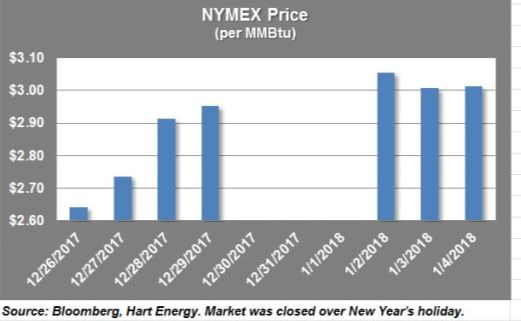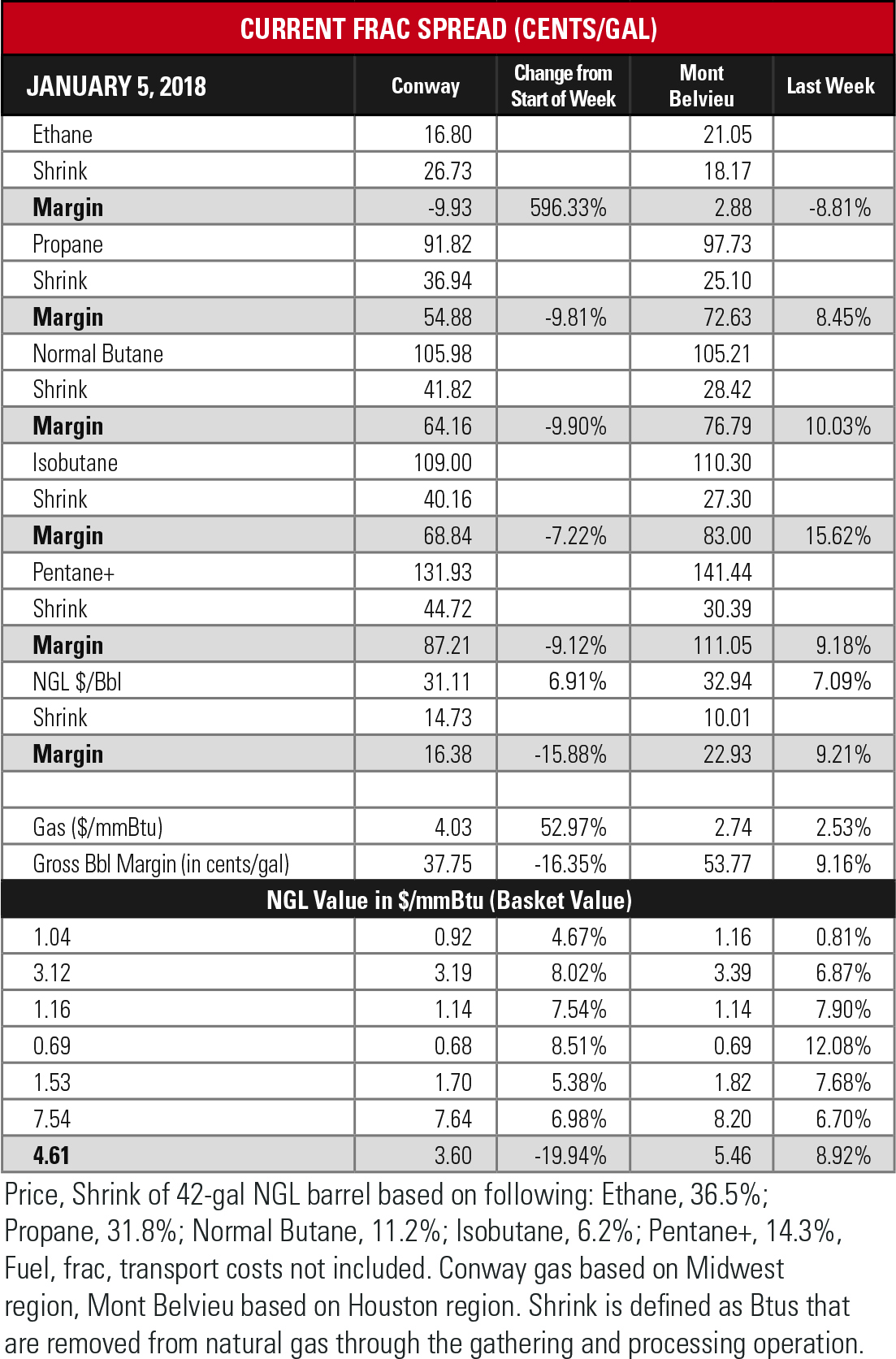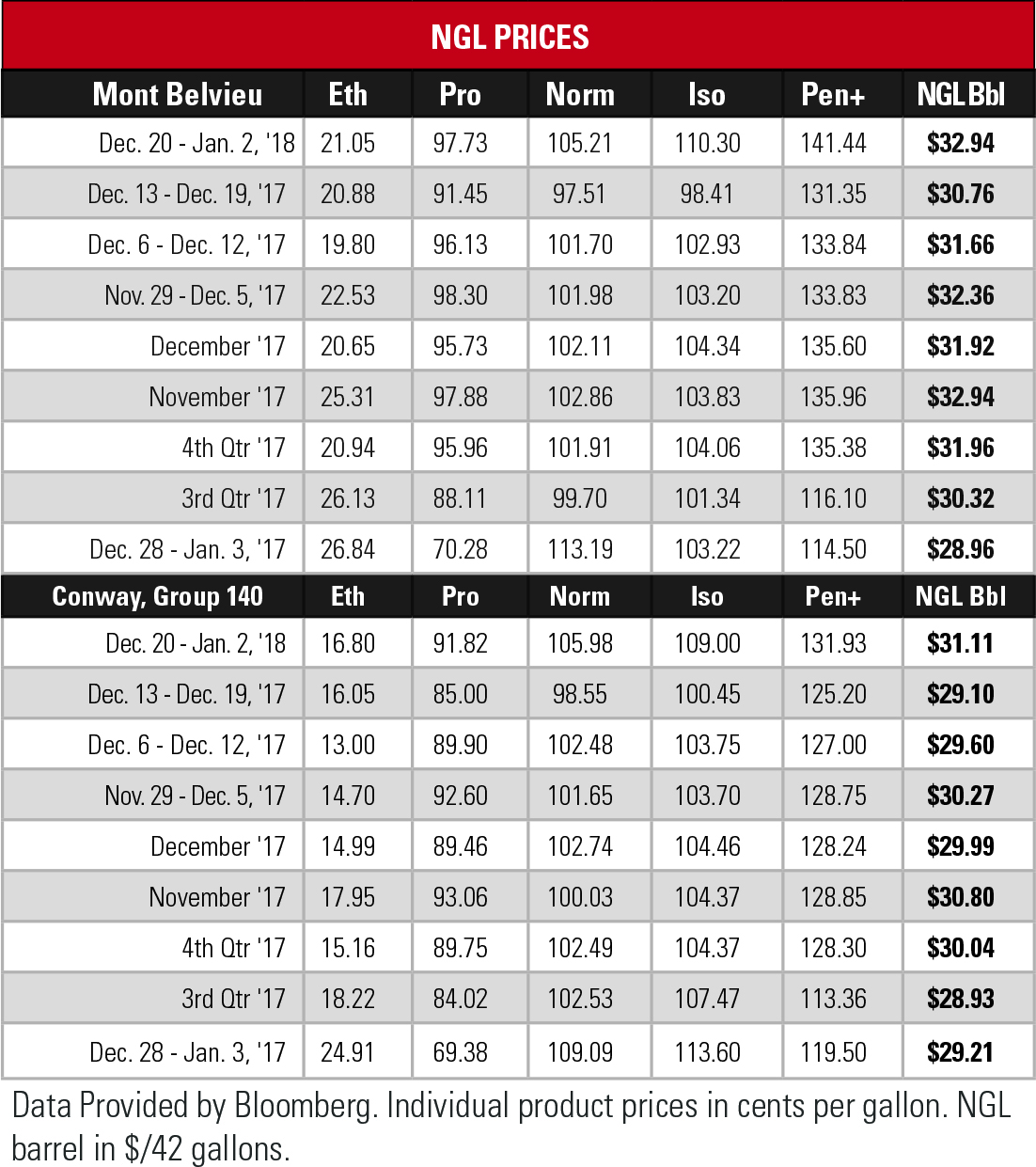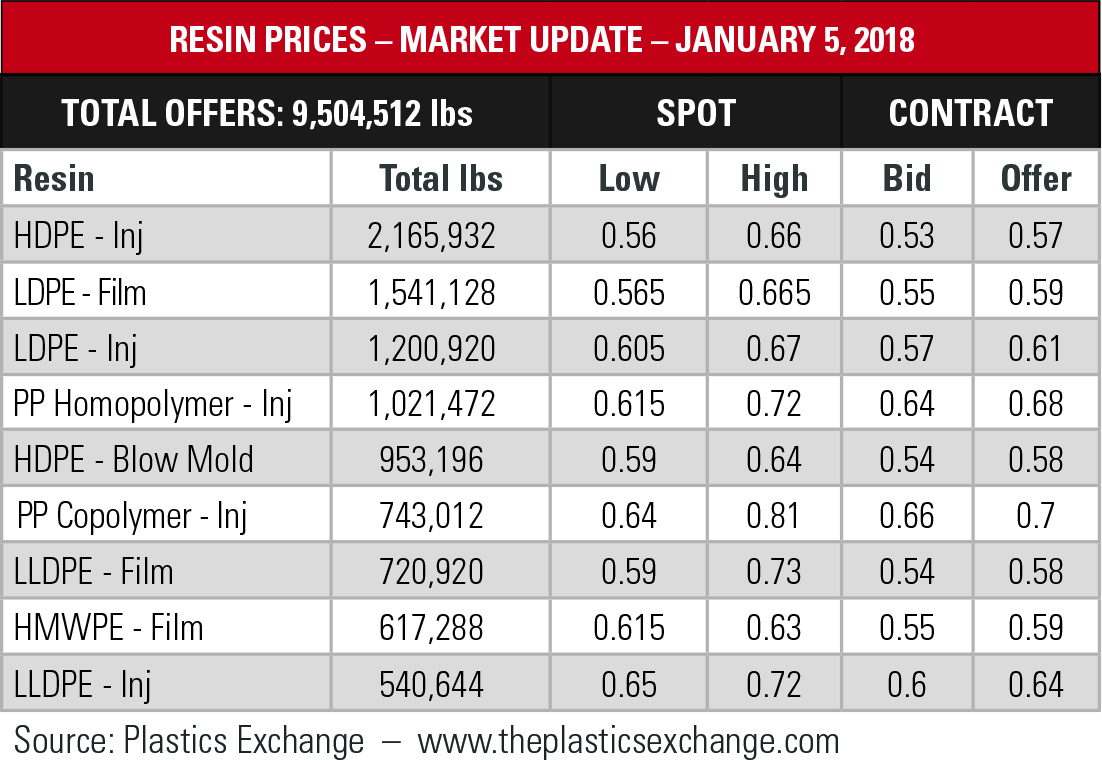
Daily NGL prices for 2017 per gallon. (Source: Hart Energy, Bloomberg)
The assault by an arctic chill that jolted natural gas consumption to a record 143 billion cubic feet on New Year’s Day has been largely deflected in terms of price so far by commodity markets aware of the U.S. superabundance of supply.
By morning Jan. 4, the New York Mercantile Exchange (NYMEX) price had slipped 4.3 cents from its Jan. 2 close to $3.013 per million Btu (MMBtu).
 Selected spot natural gas prices, however, responded to suddenly soaring demand with skyrocketing prices. The Katy, Texas, Hub closed on Jan. 3 at $6.38/MMBtu, the Ellisburg, N.Y., hub at $5.94/MMBtu and numerous other hubs closed between $5.50 and $6/MMBtu, up from less than $3/MMBtu on Dec. 26. The cold snap pushed prices for New England delivery last week to $53.50/MMBtu while the New York Hub saw a close of $46.53/MMBtu on Jan. 3.
Selected spot natural gas prices, however, responded to suddenly soaring demand with skyrocketing prices. The Katy, Texas, Hub closed on Jan. 3 at $6.38/MMBtu, the Ellisburg, N.Y., hub at $5.94/MMBtu and numerous other hubs closed between $5.50 and $6/MMBtu, up from less than $3/MMBtu on Dec. 26. The cold snap pushed prices for New England delivery last week to $53.50/MMBtu while the New York Hub saw a close of $46.53/MMBtu on Jan. 3.
The winter storm referred to as “bombogenesis,” or a storm that rapidly intensifies and causes a rapid change of pressure, crippled the East Coast from New England to the Carolinas, though it was expected to ease the frigid conditions temporarily. However, it could also dump as much as 10 to 15 inches of snow on Maine, according to some forecasts.
The snowstorm was expected to move through by Jan. 4 but a new front is forecast to immediately follow, bringing dangerously strong wind gusts of up to 60 mph and brutally low temperatures to the region, according to AccuWeather.
Nevertheless, there is plenty of gas for heating needs.
“Rapid production growth that has unfolded in the second half of 2017 has limited concerns of supply shortage this winter,” Teri Viswanath, analyst at PIRA Energy Group, told the Financial Times. Even demand from the sustained very low temperatures is being met by strong gas production from the Marcellus Shale and the Permian Basin.
 The high demand cut into storage of natural gas in the Lower 48, which experienced a decrease of 206 billion cubic feet (Bcf) in the week ended Dec. 29, the U.S. Energy Information Administration reported, compared to the Bloomberg consensus of a 219 Bcf draw and the 2016 draw of 76 Bcf. The figure also contrasts with the five-year average decrease of 99 Bcf, resulting in a total of 3.126 trillion cubic feet (Tcf). That is 5.8% below the 3.318 Tcf figure at the same time in 2016 and 5.8% below the five-year average of 3.318 Tcf.
The high demand cut into storage of natural gas in the Lower 48, which experienced a decrease of 206 billion cubic feet (Bcf) in the week ended Dec. 29, the U.S. Energy Information Administration reported, compared to the Bloomberg consensus of a 219 Bcf draw and the 2016 draw of 76 Bcf. The figure also contrasts with the five-year average decrease of 99 Bcf, resulting in a total of 3.126 trillion cubic feet (Tcf). That is 5.8% below the 3.318 Tcf figure at the same time in 2016 and 5.8% below the five-year average of 3.318 Tcf.
Ethane soared at Mont Belvieu, Texas, recording a 13.9% single-trading day jump in price from Dec. 29 to Jan. 2 to 22.6 cents per gallon (gal). At Conway, Kan., the price rose by 7.5%. Propane and C5+ moved little. Butanes, which had rallied in late December, took a hit.
 The ethane margin at Mont Belvieu took a beating, narrowing by almost 9% to less than 3 cents/gal. At the end of third-quarter 2017, the Mont Belvieu ethane margin was 7.65 cents/gal.
The ethane margin at Mont Belvieu took a beating, narrowing by almost 9% to less than 3 cents/gal. At the end of third-quarter 2017, the Mont Belvieu ethane margin was 7.65 cents/gal.
Ethane margins endured a rough fourth-quarter 2017. At Mont Belvieu, the margin narrowed by 43% compared to fourth-quarter 2016, though the December 2017 to December 2016 comparison saw a 9% increase. The 16.5% drop in ethane’s December 2017 price at Conway wreaked havoc with the margin there.
Propane’s average price dipped in December but its margin more than doubled at both hubs compared to December 2016. In the six trading days from Dec. 20 to Jan. 2, propane rose 6.9% at Mont Belvieu and 8% at Conway.
Butanes pushed back over $1/gal at both hubs and C5+ rose 7.7% at Mont Belvieu to eclipse $1.40/gal for the first time since December 2014.
 Joseph Markman can be reached at jmarkman@hartenergy.com and @JHMarkman.
Joseph Markman can be reached at jmarkman@hartenergy.com and @JHMarkman.
Recommended Reading
After BKV’s IPO, Is Market Open to More Public SMID Caps?
2024-10-03 - The market for new E&P and energy IPOs has been tepid since the COVID-19 pandemic. But investor appetite is growing for new small- and mid-sized energy IPOs, says Citigroup Managing Director Dylan Tornay.
Investor Returns Keep Aethon IPO-ready
2024-10-08 - Haynesville producer Aethon Energy is focused on investor returns, additional bolt-on acquisitions and mainly staying “IPO ready,” the company’s Senior Vice President of Finance said Oct. 3 at Hart Energy’s Energy Capital Conference (ECC) in Dallas.
Cibolo Energy Closes Fund Aimed at Upstream, Midstream Growth
2024-09-10 - Cibolo Energy Management LLC closed its second fund, Cibolo Energy Partners II LP, meant to boost middle market upstream and midstream companies’ growth with development capital.
Record NGL Volumes Earn Targa $1.07B in Profits in 3Q
2024-11-06 - Targa Resources reported record NGL transportation and fractionation volumes in the Permian Basin, where associated natural gas production continues to rise.
BKV Prices IPO at $270MM Nearly Two Years After First Filing
2024-09-25 - BKV Corp. priced its common shares at $18 each after and will begin trading on Sept. 26, about two years after the Denver company first filed for an IPO.
Comments
Add new comment
This conversation is moderated according to Hart Energy community rules. Please read the rules before joining the discussion. If you’re experiencing any technical problems, please contact our customer care team.






